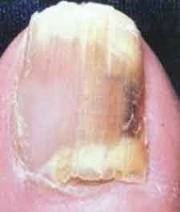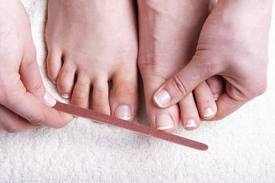Posts Tagged ‘nails’
Some Useful Information When Looking for Nail Fungus Treatments
Some Useful Information When Looking
for Nail Fungus Treatments
 Nail fungus, known medically as Onychomycosis, is not an easy condition to treat. Primarily cosmetic in nature, it most commonly affects the toenails.
Nail fungus, known medically as Onychomycosis, is not an easy condition to treat. Primarily cosmetic in nature, it most commonly affects the toenails.
People who are at risk for contracting nail fungus are:
- Older people,
- Males,
- People with diabetes
- People who have had trauma to their nails
- People with hyperhydrosis
- People who suffer from peripheral vascular disease
- People who have athlete’s foot
- People with an immunodeficiency
- People who practice poor hygine
- People who spend a lot of time in the water
There are a number of different species of fungus that can infect the nail. It is also common to find several different fungal infections at one time. The visible symptoms of nail fungus are a thick, discolored and distorted looking nail.
Curing nail fungus has historically been problematic. Modern medicine has found several new options for curing nail fungus. Visiting your health care provider to determine what kind of infection you have and confirming that it is in fact a nail fungus, instead of some other nail infection, is paramount to a successful treatment regimen. Discovery of this is fairly simple. Your doctor can take scrapings and/or clippings of the infected nail to examine under a microscope, and if necessary, send to a lab for culture.
Once you know what you are dealing with, your nail fungus treatment can begin. A common treatment option is an oral prescription antifungal medication. Two older, and therefore proven and well documented, medications are griseofulvin and fluconazole. Unfortunately these medications aren’t effective on all forms of nail fungus and for the fluconazole, the treatment can last up to 9 months.
Two new comparatively to the market prescription medications that have proven effective against nail fungus are terbinafine and itaconazole. These have both proven to be more effective than their older cousins, fluconazole and griseofulvin.
Terbinafine is taken daily over the course of three months. It is reported to be well tolerated with no negative drug interactions with other medications or significant side effects.
Itaconazole runs in a weekly cycle of three weeks on and three weeks off over the course of 3-5 months. People who take a protease inhibitor should not take itaconazole.
For those who do not wish to take an oral prescription, there are alternatives.
A topical medication is now available for curing nail fungus. Your doctor can prescribe using a nail polish containing 8% ciclopirox solution. You paint this on your nail, as you would a regular nail polish, and the adjacent skin every day for 12 months. This treatment is not as effective as oral prescription medication and the course of treatment is lengthy.
As you consider how to treat your onychomycosis, please keep in mind that no matter what medication you choose and however long the treatment cycle is, the nail has to grow out completely clear before the fungus is considered gone. It can take some people more than a year to replace a disfigured toenail.
There are some folks who opt for surgery. This is a more drastic treatment for nail fungus and should be considered a later option as it can be both painful and possibly disfiguring. If other options are unavailable to you because other medications are either ineffective or inappropriate, this can be a good solution to your nail fungus problem.
Alternative medicine treatments are another possible solution. Tea Tree Oil has been shown in some studies to cure nail fungus. The Mayo Clinic has one published report if you are interested in reading up on this treatment.
There are many home remedies that have been suggested by individuals who have had success with them. Most of these are not considered to be viable treatments by the medical community, but that does not mean they cannot prove effective. Home remedies include:
- A 20-30 minute foot soak in vinegar, lemon juice, Listerine, or a solution of bleach
- Nutritional supplements such as acidophilus
- Applying baking soda, garlic, olive oil or Vick’s VapoRub to the infected nail
Modern medicine has created many successful options when it comes to curing nail fungus. Consulting your health care provider and doing some research yourself are two positive steps in the right direction. Armed with the correct information, you and your health care provider can create an effective plan to solve your nail fungus problem.
What Nails Are and How They Become Infected
What Nails Are and How They Become Infected
 Our nails look like clear, hard sheathes that cover part of our finger and eventually grow out over the edge. Most people have a bit of a pinkish tinge underneath their nails. The nail itself isn’t pink but allows the color of the skin and blood vessels directly underneath to show through. This is what a normal, healthy nail should look like.
Our nails look like clear, hard sheathes that cover part of our finger and eventually grow out over the edge. Most people have a bit of a pinkish tinge underneath their nails. The nail itself isn’t pink but allows the color of the skin and blood vessels directly underneath to show through. This is what a normal, healthy nail should look like.
A nail infection discolors the nail to a whitish or yellowish color at first, then as it grows, brown and black can become part of the color scheme.
Nails are made up of keratin, the same protein that builds our hair and the outmost layer of our skin. Keratin is a strong-celled protein that is fairly diverse. For our nails, it builds this lovely sheath to protect the soft part of the nail from harm.
How Does Infection Get Into the Nail?
Really what happens is that a fungal infection gets under the nail. Just like their cousins, the mushroom, the fungal spores that grow and invade the nail bed want to be in a warm, dark, damp place to grow. We come into contact with these spores on a regular basis. Some of them are harmless and wash off with no effect to us. Others try to seek a parasitic relationship with our bodies, using us as a means to grow and spread themselves.
Most people don’t realize when or where they might come into contact with these parasitic fungal spores. The answer is, pretty much everywhere. Germs, viruses, and spores are part of the make-up of our eco-system. Having a healthy immune system is what allows our bodies to fight these things off.
The fungus that most commonly causes nail infection is called a dermatophyte. We come into contact with them every day and for most people, no harm is caused. However, for people with certain diseases, like diabetes, or who have poor circulation, or even who have been sick for a long time, so their immune system has been working overtime, these parasitic fungi find a happy breeding ground. The most commonly affected area is the toenail, as it is usually kept in the dark and surrounded by warm fabric that has the potential to hold in moisture. Fingernail fungus infections occur most often in people who spend a great deal of time with their hands in the water or exposed to harsh chemicals.
Fungus grow very slowly, so by the time the infected person notices the discoloration of their nail, the fungus has already established a fairly good hold on the nail. Usually it gets underneath the nail at the tip of the toe by working its way underneath and into the protected nail bed. It can also get into the soft tissue surrounding the nail and work its way under from there. Nail Fungus Infections aren’t incredibly dangerous, but they do take a very long time to treat, as the fungus isn’t gone until the nail has grown out entirely clear.
What can I do to prevent it?
There are lots of ways you can prevent nail fungus from getting to your nails in the first place. This is your best bet.
- Keep your nails trimmed close to the edge of the finger or toe tip. The less space there is at the edge of the nail for the fungus to get on, the less likely it will be to grow.
- Wash your hands and feet regularly and dry them thoroughly. Wear clean socks every day and make sure your shoes dry out entirely before wearing them, especially if you wear the same shoes every day.
- Wear something on your feet when in public areas that have a lot of water, like swimming pools or locker rooms. And make sure those shoes have a chance to dry out too!
If I Get Infected, How Do I Treat It?
There are a great many home remedies suggested on this and other websites. Over-the-counter remedies and medications are another good idea. If you’re going to try to treat it yourself, start working with one of these remedies and wash the affected area at least twice a day, then dry it thoroughly. Wear clean socks if it’s a toenail infection, even to the point of changing your socks a couple times a day. Right after washing your feet. And if it is possible for you to wear sandals, exposing your feet to the light also helps.
If your infection is severe or well advanced, a visit to your doctor to figure out what kind of fungal infection it is and what treatment options are available to you will be your next step.